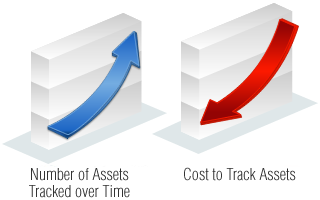 Asset Tracking – Top Ten Trends
Asset Tracking – Top Ten Trends
More and more assets are being tracked. Traditionally, only large,
capital assets were tracked, but increasingly companies and individuals are tracking all assets,
capital or not, even those written off long ago. Even if they are fully depreciated,
they are still valuable and still need to be counted. After all, they are still potentially valuable,
given tax write-off schedules and active online markets for used equipment.
Smaller and smaller assets are being tracked. A 10-ton punch press will
always be tracked, but now smaller and smaller items are more and more valuable. As schools,
clinics, and business begin to track laptops, medicinal tools, and electronica, asset tracking
and tags become universal.
Intangible Intellectual Property (IP) assets are being tracked. Server- and web-hosted prints, databases, and files have enormous value. Physical forms and the backups of the IP (e.g. the PC, the server, tapes, file cabinet, DVD of images, etc.), have been tracked as long as files have become digital,
but companies are now recording access times, security clearances, and relevant database files for IP assets.
Given the increasing value (and tracking of) physically small or intangible assets,
it is easy to see that a related trend can – and does – emerge: asset theft.
Physically, these assets are easier to steal than a wooden desk, and financially, these assets are more
valuable to steal than a wood desk. For some larger institutions, the real problem is actually not
just theft, but “spontaneous appropriation” of inadequately protected information by another department.
Asset tracking software is being used by smaller and smaller organizations.
The Sarbanes–Oxley Act of 1998 had a major impact on how public businesses track assets. But the regulations
imposed by the Act have also had an indirect and trickle-down effect on practices of small 501 (c) 3 organizations
and primary schools. School district funding, in many cases, is now awarded and renewed based on asset holdings,
and contingent upon their exact tracking. Donors to not-for-profits and trustees of charitable foundations want
to know how their gifts are utilized, which assets are purchased with them, and when and whether these purchases
are decommissioned. To retain and encourage donors, recipient organizations need to ensure (and articulate the fact that)
funds or taxes are not used frivolously. In that case, every dollar must be counted – and every asset, tracked.
Consumers are tracking their assets, too! That is, everybody keeps track of the
things they love, whether labeling bottles in a wine cellar, books on a shelf, or golf clubs and tools
in a home garage. Any bike owner knows that an unregistered bike, once lost or stolen, is never coming back.
The solution is a site like
this free bike registry, which enables
individuals or schools to track, catalog, (and occasionally find!) each bike. And of course, a home asset
tracking system assists in insurance claims, in case of theft or accident.
SmartPhone barcode scanning is another growing trend in asset tracking.
Free SmartPhone applications allow any smartphone owner to photograph a printed barcode and
instantly read it. The code can even automatically link the user to that asset’s web page.
Another way of saying: Why purchase a Motorola / Symbol scanner for $500 when you can just use your iPhone?
Assets are tracked across remote locations. For any school district, large business,
or other multi-locational network, an asset tracking system that crosses geographical boundaries increases
both efficient use of assets and accountability in case of loss. This not only streamlines transfer of
assets from one office to another, but exerts a powerful deterrent to asset leakage (e.g. somehow losing a
valuable from an office that has little direct supervision).
Assets don’t live in isolation. Their value depends on regular system maintenance and fast turn-around.
Valuable assets tend to get used more frequently (users need to a reserve a time to get access to the asset).
As a result, more and more asset tracking systems
incorporate maintenance scheduling as well as
Check-In/Check-Out functions.
Asset tracking is moving to the Cloud. Original stand-alone software costs as much
as $1,000, and requires time and people to train in its maintenance. Now, that software is
growing my moving rapidly to the web – at cheaper cost. More secure, remotely accessible
and easy to learn, web-based asset tracking systems, and the asset tags that are their hallmarks,
are compelling, practical, and low-cost methods of asset maintenance, inventory, and recovery.

 Asset Tracking – Top Ten Trends
Asset Tracking – Top Ten Trends









 Asset Tags – Top Six Trends
Asset Tags – Top Six Trends




 RFID Asset Tags – Is this the "Next Big Thing"?
RFID Asset Tags – Is this the "Next Big Thing"?